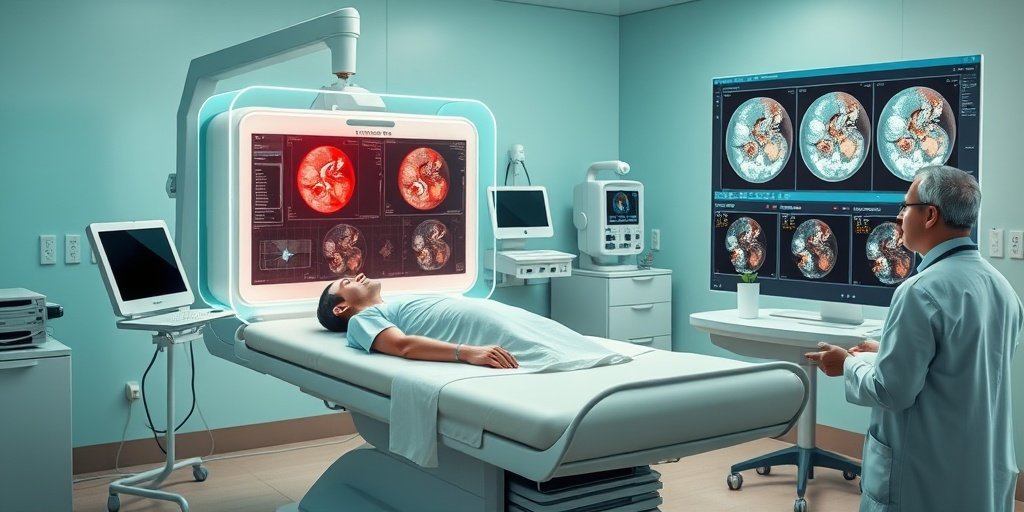⚡ Quick Summary
The study introduces ProMUS-NET, an artificial intelligence model that significantly enhances the detection of prostate cancer on micro-ultrasonography (MUS). This AI model outperformed expert urologists, achieving a lesion-level sensitivity of 73% compared to 58% for urologists.
🔍 Key Details
- 📊 Dataset: MUS images from patients undergoing MRI-ultrasonography fusion guided biopsy
- 🧩 Features used: International Society of Urological Pathology Grade Group (GG) ≥2 cancer locations
- ⚙️ Technology: Deep learning model – ProMUS-NET (no-new U-Net)
- 🏆 Performance: AUC of 0.92, lesion-level sensitivity 73%, patient-level sensitivity 77%
🔑 Key Takeaways
- 🤖 AI model ProMUS-NET shows great promise in detecting prostate cancer.
- 📈 High sensitivity for peripheral zone lesions at 86.2%.
- 🧑⚕️ Urologists had lower sensitivity rates at 58% for lesion-level detection.
- 🔍 Study involved a fivefold cross-validation for robust performance evaluation.
- 📅 Ongoing work aims to improve margin overlap and reduce false positives.
- 🌍 Potential for AI to enhance biopsy diagnosis in urology.

📚 Background
Prostate cancer remains a leading cause of cancer-related morbidity among men. Traditional methods of cancer detection, including biopsies, can be invasive and may not always yield accurate results. The integration of artificial intelligence into diagnostic imaging, particularly through micro-ultrasonography, offers a promising avenue for improving detection rates and patient outcomes.
🗒️ Study
Conducted at a single institution, this study involved a prospective collection of MUS images from patients undergoing MRI-ultrasonography fusion guided biopsy. The researchers aimed to develop a deep learning model, ProMUS-NET, to automatically segment and localize clinically significant prostate cancer lesions, specifically those classified as GG ≥2.
📈 Results
The ProMUS-NET model achieved an impressive area under the receiver-operating characteristic curve (AUC) of 0.92. In terms of sensitivity, the AI model detected lesions with a 73% sensitivity at the lesion level, surpassing the 58% sensitivity of expert urologists. Furthermore, the model demonstrated an even higher sensitivity of 86.2% for lesions located in the peripheral zone.
🌍 Impact and Implications
The findings from this study highlight the transformative potential of AI in the field of urology. By enhancing the accuracy of prostate cancer detection, ProMUS-NET could lead to better-targeted biopsies and ultimately improve patient management strategies. As AI continues to evolve, its integration into clinical practice could significantly reduce the burden of prostate cancer diagnosis and treatment.
🔮 Conclusion
The development of ProMUS-NET marks a significant advancement in the use of artificial intelligence for prostate cancer detection. With its high sensitivity and specificity, this AI model has the potential to revolutionize how urologists approach biopsy diagnosis. Continued research and validation are essential to fully realize the benefits of AI in clinical settings, paving the way for improved patient outcomes.
💬 Your comments
What are your thoughts on the integration of AI in prostate cancer detection? We would love to hear your insights! 💬 Share your comments below or connect with us on social media:
ProMUS-NET: Artificial intelligence detects more prostate cancer than urologists on micro-ultrasonography.
Abstract
OBJECTIVES: To improve sensitivity and inter-reader consistency of prostate cancer localisation on micro-ultrasonography (MUS) by developing a deep learning model for automatic cancer segmentation, and to compare model performance with that of expert urologists.
PATIENTS AND METHODS: We performed an institutional review board-approved prospective collection of MUS images from patients undergoing magnetic resonance imaging (MRI)-ultrasonography fusion guided biopsy at a single institution. Patients underwent 14-core systematic biopsy and additional targeted sampling of suspicious MRI lesions. Biopsy pathology and MRI information were cross-referenced to annotate the locations of International Society of Urological Pathology Grade Group (GG) ≥2 clinically significant cancer on MUS images. We trained a no-new U-Net model – the Prostate Micro-Ultrasound Network (ProMUS-NET) – to localise GG ≥2 cancer on these image stacks in a fivefold cross-validation. Performance was compared vs that of six expert urologists in a matched sub-cohort.
RESULTS: The artificial intelligence (AI) model achieved an area under the receiver-operating characteristic curve of 0.92 and detected more cancers than urologists (lesion-level sensitivity 73% vs 58%; patient-level sensitivity 77% vs 66%). AI lesion-level sensitivity for peripheral zone lesions was 86.2%.
CONCLUSIONS: Our AI model identified prostate cancer lesions on MUS with high sensitivity and specificity. Further work is ongoing to improve margin overlap, to reduce false positives, and to perform external validation. AI-assisted prostate cancer detection on MUS has great potential to improve biopsy diagnosis by urologists.
Author: [‘Zhou SR’, ‘Zhang L’, ‘Choi MH’, ‘Vesal S’, ‘Kinnaird A’, ‘Brisbane WG’, ‘Lughezzani G’, ‘Maffei D’, ‘Fasulo V’, ‘Albers P’, ‘Fan RE’, ‘Shao W’, ‘Sonn GA’, ‘Rusu M’]
Journal: BJU Int
Citation: Zhou SR, et al. ProMUS-NET: Artificial intelligence detects more prostate cancer than urologists on micro-ultrasonography. ProMUS-NET: Artificial intelligence detects more prostate cancer than urologists on micro-ultrasonography. 2025; (unknown volume):(unknown pages). doi: 10.1111/bju.16892